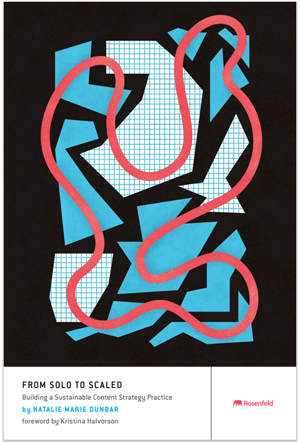
If you’re building a user-centred design team, then you need Natalie Marie Dunbar’s book From Solo to Scaled: Building a Sustainable Content Strategy Practice.
Of course, if you’re building a content strategy practice – maybe from solo, but also if you’re widening your scope – then you’ll automatically want to read this book.
I’m going to say straight off that I might not have bought this book. I don’t do much content strategy, and there are many other books waiting to be read in my pile. But I met Natalie in an online meeting and really liked her combination of practical commonsense and wide-ranging knowledge. And one of the lovely things about being a Rosenfeld Media author is that they will send you a copy of any of their books – so I asked for this one.
What a treat! It’s like having Natalie in the room, quietly but firmly helping you to identify and deal with some of the knottier challenges when getting an organisation to accept a new type of team doing a sort of work that maybe isn’t yet fully embedded.
Natalie is a content strategist, and a content designer. She’s very clear on how those roles overlap and intersect, which is useful. But more importantly, she has loads of experience of being the lone person in a team, or the lone member of an agency, and how to get work accepted and contributions valued.
This book is NOT about doing the work of content strategy, or content design, or user research, or any of the other types of work that are necessary in user-centred design.
It’s about building the practice. For example, you’ll learn about the Content Strategy Practice Blueprint:
- Making the business case
- Building strong relationships with cross-functional teams
- Creating frameworks and curating tools to build with
- Rightsizing the practice to meet client or project demand
- Establishing meaningful success measures.
Now – she calls that the “content strategy” practice blueprint. But I was constantly thinking “I wish I’d had this book to guide me when I was trying to build a user research, or user-centred design, practice when working with all sorts of clients in the past”.
If you are a content designer or content strategist, you’ll find a ton of relevant examples in the book. But even if your own discipline is a different one, such as user research, you’ll be working with content designers and it’s immensely useful to have their point of view. And the management skills and thought processes apply to all of us.
Just think: something that actually helps you with the business case! Worth the whole book for that alone.
